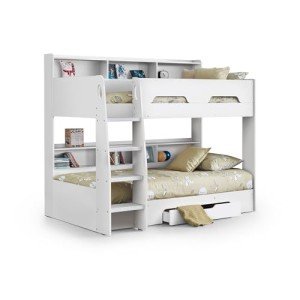Title: The Ultimate Guide to Kids Bunk Beds
Introduction
As children grow, so does their requirement for space and storage options. Bunk beds are an exceptional way to take full advantage of area while supplying an enjoyable and practical sleeping plan for your kids. This thorough guide will explore the different types, advantages, safety considerations, and FAQs related to kids bunk beds.
I. Types of Kids Bunk Beds
- Standard Bunk Beds: These are the most common type, including two twin-sized beds stacked on top of each other.
- Futon Bunk Beds: The bottom bunk is replaced with a futon, offering a couch and a bed in one piece of furniture.
- Twin-Over-Full Bunk Beds: The bottom bunk is larger, accommodating a full-sized mattress, while the leading bunk is a twin.
- L-Shaped Bunk Beds: These include 2 beds put perpendicularly, offering more flooring area underneath.
- Loft Bunk Beds: A single bed is placed on a raised platform, leaving space for a desk, play location, or storage beneath.
II. Benefits of Kids Bunk Beds
- Space-Saving: Bunk beds are ideal for smaller sized bedrooms, maximizing flooring area for other activities and furniture.
- Fun and Exciting: Children frequently take pleasure in the novelty and experience of climbing up to their own private sleeping area.
- Cost-Effective: Purchasing one bunk bed is more economical than purchasing 2 different beds.
- Versatile: Many bunk beds can be separated into two different beds as children age or when space enables.
- Integrated Storage: Some bunk beds feature built-in storage options, such as drawers, desks, or shelves.
III. Safety Considerations
- Strong Construction: Ensure the bunk bed is made from sturdy, long lasting materials and has a protected ladder for safe access.
- Proper Spacing: Gaps between the mattress and the frame ought to be less than 3.5 inches to avoid entrapment.
- Proper Height: Select a bunk bed with an appropriate height for your child, considering their age, size, and capability to go up and down safely.
- Secure Mattresses: Use the right size mattress and protect it to the bed frame to prevent it from shifting during sleep.
- Guardrails: Ensure guardrails are installed on both sides of the leading bunk and are at least 5 inches higher than the top of the bed mattress.
IV. Frequently asked questions
- What is the ideal age for a child to sleep on the top bunk?It is generally advised to wait till a child is at least 6 years old before permitting them to sleep on the leading bunk.
- Can bunk beds be separated into two different beds?Yes, some bunk beds can be taken apart and converted into 2 different beds.
- How much area is required between the bottom of the leading bunk and the top of the bottom bunk?A minimum of 2 feet 8 inches is suggested for head clearance on the bottom bunk.
- Are bunk beds safe for children?When correctly assembled and used, bunk beds are safe for children. Always follow safety guidelines and ensure your child comprehends the rules for using the bunk bed.
V. Conclusion
Kids bunk beds are a useful and enjoyable service for optimizing area and supplying an unique sleeping experience for your children. By thinking about sale bunk beds , benefits, and safety considerations, you can make an informed decision when selecting the best bunk bed for your household.

